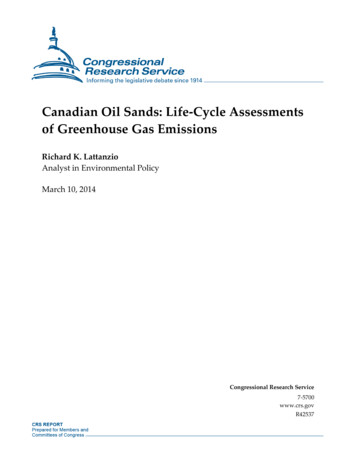
Transcription
Canadian Oil Sands: Life-Cycle Assessmentsof Greenhouse Gas EmissionsRichard K. LattanzioAnalyst in Environmental PolicyMarch 10, 2014Congressional Research Service7-5700www.crs.govR42537
Canadian Oil Sands: Life-Cycle Assessments of Greenhouse Gas EmissionsSummaryCanadian Oil Sands and Climate ChangeRecent congressional interest in U.S. energy policy has focused in part on ways through whichthe United States could secure more economical and reliable petroleum resources bothdomestically and internationally. Many forecasters identify petroleum products refined fromCanadian oil sands as one possible solution. Increased production from Canadian oil sands,however, is not without controversy, as many have expressed concern over the potentialenvironmental impacts. These impacts include emissions of greenhouse gases (GHG) duringresource extraction and processing. A number of key studies in recent literature have expressedfindings that GHG emissions per unit of energy produced from Canadian oil sands crudes arehigher than those of other crudes imported, refined, and consumed in the United States. Thestudies identify two main reasons for the difference: (1) oil sands are heavier and more viscousthan lighter crude oil types on average, and thus require more energy- and resource-intensiveactivities to extract; and (2) oil sands are chemically deficient in hydrogen, and have a highercarbon, sulfur, and heavy metal content than lighter crude oil types on average, and thus requiremore processing to yield consumable fuels by U.S. standards.Selected Findings from the Primary Published StudiesCRS surveyed the published literature, including the U.S. State Department-commissioned studyfor the Keystone XL pipeline project in both the 2011 Final Environmental Impact Statement andthe 2014 Final Supplementary Environmental Impact Statement. The primary literature revealsthe following: Canadian oil sands crudes are generally more GHG emission-intensive than othercrudes they may displace in U.S. refineries, and emit an estimated 17% moreGHGs on a life-cycle basis than the average barrel of crude oil refined in theUnited States; compared to selected imports, Well-to-Wheels GHG emissions for Canadian oilsands crudes range from 9% to 19% more emission-intensive than MiddleEastern Sour, 5% to 13% more emission-intensive than Mexican Maya, and 2%to 18% more emission-intensive than various Venezuelan crudes; compared to selected energy- and resource-intensive crudes, Well-to-WheelsGHG emissions for Canadian oil sands crudes are within range of heavier crudessuch as Venezuelan Bachaquero and Californian Kern River, as well as lightercrudes that are produced from operations that flare associated gas (e.g., NigerianBonny Light); discounting the final consumption phase of the life-cycle assessment (which cancontribute up to 70%-80% of Well-to-Wheels emissions), Well-to-Tank (i.e.,“production”) GHG emissions for Canadian oil sands crudes are 9%-102%higher than for selected imports; the estimated effect of the Keystone XL pipeline on global GHG emissionsremains uncertain, as some speculate that its construction would encourage anexpansion of oil sands investment and development, while others suggest that theproject would not substantially influence either the rate or magnitude of oilCongressional Research Service
Canadian Oil Sands: Life-Cycle Assessments of Greenhouse Gas Emissionsextraction activities in Canada or the overall volume of crude oil transported toand refined in the United States.Scope and Purpose of This ReportCongressional interest in the GHG emissions attributable to Canadian oil sands crudes hasencompassed both a broad understanding of the resource as well as a specific assessment of theproposed Keystone XL pipeline. This report discusses the basic methodology of life-cycleassessments and compares several of the publicly available studies of GHG emissions data forCanadian oil sands crudes against each other and against those of other global reference crudes.For a detailed analysis of the GHG emissions attributable to the proposed Keystone XL pipeline,and the findings from the State Department’s Final Environmental Impact Statement, see CRSReport R43415, Keystone XL: Greenhouse Gas Emissions Assessments in the FinalEnvironmental Impact Statement, by Richard K. Lattanzio.Congressional Research Service
Canadian Oil Sands: Life-Cycle Assessments of Greenhouse Gas EmissionsContentsIntroduction. 1Scope and Purpose of This Report . 2Life-Cycle Assessment Methodology . 3Key Factors in the Assessment of Canadian Oil Sands Crudes . 4Results of Selected Life-Cycle Emissions Assessments . 7Life-Cycle Assessments of Canadian Oil Sands Crudes . 7Findings . 9Design Factors and Input Assumptions for Life-Cycle Assessments of CanadianOil Sands Crudes . 18Life-Cycle Assessments of Canadian Oil Sands Crudes versus Other ReferenceCrudes. 22Findings . 22Design Factors and Input Assumptions for Life-Cycle Assessments of ReferenceCrudes . 23Life-Cycle Assessments of Canadian Oil Sands Crudes versus Other Fuel Resources. 26Further Considerations. 27FiguresFigure 1. Crude Oil Life-Cycle Schematic . 4Figure 2. Well-to-Wheels GHG Emissions Estimates for Canadian Oil Sands Crudes . 11Figure 3. Well-to-Wheels GHG Emissions Estimates for Global Crude Resources . 25Figure 4. Life-Cycle GHG Emissions Estimates for Selected Fuel Resources. 26TablesTable 1. Life-Cycle Assessments of Canadian Oil Sands Crudes . 8Table 2. Reported Findings of Well-to-Wheels GHG Emissions Estimates in theLife-Cycle Assessments of Canadian Oil Sands Crudes . 12Table 3. Potential GHG Mitigation Activities in Canadian Oil Sands Production . 27ContactsAuthor Contact Information. 28Acknowledgments . 28Congressional Research Service
Canadian Oil Sands: Life-Cycle Assessments of Greenhouse Gas EmissionsIntroductionRecent congressional interest in U.S. energy policy has focused in part on ways through whichthe United States could secure more economical and reliable petroleum resources bothdomestically and internationally. Many forecasters identify petroleum products refined fromCanadian oil sands1 as one possible solution. Canadian oil sands account for about 56% ofCanada’s total crude oil production, and that number is expected to rise from its current level of1.8 million barrels per day (mbd) in 2012 to 5.2 mbd by 2030.2 Further, the infrastructure toproduce, upgrade, refine, and transport the resource from Canadian oil sands reserves to theUnited States is in place, and additional infrastructure projects—such as the Keystone XLpipeline—have been proposed.3 Increased production from Canadian oil sands, however, is notwithout controversy, as many have expressed concern over the potential environmental impacts.These impacts may include increased water and natural gas use, disturbance of mined land,effects on wildlife and water quality, trans-boundary air pollution, and emissions of greenhousegases (GHG) during extraction and processing.4A number of key studies in recent literature have expressed findings that GHG emissions per unitof energy produced from Canadian oil sands crudes are higher than those of other crudesimported, refined, and consumed in the United States.5 While GHG emissions and other airquality issues originating in the upstream sectors of Canada’s petroleum industry may not directlyimpact U.S. National Emissions Inventories or U.S. GHG reporting per se, many environmentalstakeholders and policymakers have noted that the increased use of more emission-intensiveresources in the United States may have negative consequences for both U.S. and global energyand environmental policy.The U.S. Department of State (DOS), in response to comments on the 2010 Draft SupplementaryEnvironmental Impact Statement (2010 Draft EIS)6 for the Keystone XL pipeline project (whichwould connect oil sands production facilities in the Western Canadian Sedimentary Basin withrefinery facilities in the United States), commissioned a contractor to analyze the life-cycle GHGemissions associated with these resources in comparison to other reference crudes.7 DOSpresented this analysis in the 2011 Final Environmental Impact Statement (2011 Final EIS)released on August 26, 2011, as a “matter of policy,” but noted that neither the NationalEnvironmental Policy Act (NEPA) nor DOS regulations (22 C.F.R. 161.12) nor Executive Orders1The resource has been referred to by several terms, including oil sands, tar sands, and, most technically, bituminoussands. Because of its widespread use in academic literature, the term “oil sands” is used in this report.2For more information on oil sands resources, see Canadian Association of Petroleum Producers market wsReleases/Pages/2013-OilForecast.aspx.3For a full analysis of TransCanada’s Keystone XL Pipeline project, see CRS Report R41668, Keystone XL PipelineProject: Key Issues, by Paul W. Parfomak et al., and CRS Report R42124, Proposed Keystone XL Pipeline: LegalIssues, by Adam Vann, Kristina Alexander, and Kenneth R. Thomas.4For more discussion on environmental impacts beyond GHG emissions, see CRS Report R42611, Oil Sands and theKeystone XL Pipeline: Background and Selected Environmental Issues, coordinated by Jonathan L. Ramseur.5A list of studies surveyed in this report can be found in Table 1; an account of the finding can be found in Table 2.6For all project documents, see the State Department’s website: http://www.keystonepipeline-xl.state.gov/.7The most recent full report by the State Department’s contractor is found in U.S. Department of State, Keystone XLProject, Final Supplementary Environmental Impact Statement, Appendix U, “Life-Cycle Greenhouse Gas Emissionsof Petroleum Products from WCSB Oil Sands Crudes Compared with Reference Crudes,” January 31, 2014.Congressional Research Service1
Canadian Oil Sands: Life-Cycle Assessments of Greenhouse Gas Emissions13337 and 12114 (Environmental Effects Abroad of Major Federal Activities) legally require thatan EIS include an assessment of environmental activities outside the United States.The initial permit for the Keystone XL Project was denied due to insufficient time to prepare arigorous, thorough, and transparent review of the pipeline’s proposed routes through Nebraska. InMay 2012, Keystone filed a new permit application for a revised route, implementing a newnational interest determination. In accordance with this process, DOS released a revised DraftSupplementary EIS (Draft EIS) for the revised project on March 1, 2013, and a revised FinalSupplementary EIS (Final EIS) on January 31, 2014, including an assessment of the indirectcumulative impacts and life-cycle GHG emissions of Canadian oil sands crudes.8 While DOScommissioned a different contractor to assist with the EIS,9 the data used to determine the GHGlife-cycle emissions associated with the resource, as well as the market analysis used for supplyand demand projections, remained largely unchanged. Hence, the 2014 Final EIS made similarfindings to the 2011 Final EIS, including the following:1. Canadian oil sands crudes “are more GHG-intensive than the other heavy crudesthey would replace or displace in U.S. refineries, and emit an estimated 17%more GHGs on a life-cycle basis than the average barrel of crude oil refined inthe United States in 2005,”10 and2. “Approval or denial of any one crude oil transport project, including theproposed Project, is unlikely to significantly impact the rate of extraction in theoil sands or the continued demand for heavy crude oil at refineries in the UnitedStates.”11Opponents of the pipeline, however, are critical of this impact assessment. They contend that thelack of transport infrastructure and the price discount it occasions has already affected productionof the oil sands and, if continued, would further depress investment and development in theregion.12Scope and Purpose of This ReportThis report presents a summary of life-cycle emissions assessments of Canadian oil sands crudesand provides an analysis of their respective findings. The first section of the report, “Life-CycleAssessment Methodology,” discusses the basic methodology of life-cycle assessments andexamines the choice of boundaries, design features, and input assumptions. The second section ofthe report, “Results of Selected Life-Cycle Emissions Assessments,” compares several of thepublicly available assessments of life-cycle GHG emissions data for Canadian oil sands crudesagainst each other, against those of other global reference crudes, and against those of other fossil8Hereinafter in this report, CRS refers to the “supplementary” documents as the Draft Environmental Impact Statement(Draft EIS) and the Final Environmental Impact Statement (Final EIS), as the submission of a new permit applicationis understood to reinitiate the National Environmental Policy Act process. For further explanation, see CRS ReportR41668, Keystone XL Pipeline Project: Key Issues, by Paul W. Parfomak et al.9The first EIS was contracted to Cardno Entrix, with assistance on the GHG analysis from ICF International; thesecond EIS was contracted to Environmental Resources Management (ERM).10Final EIS, op cit., p. ES-15.11Final EIS, op cit., p. ES-16.12See, for example, Natural Resources Defense Council, “Say No to Tar Sands Pipeline,” March 2011, pgr.pdf.Congressional Research Service2
Canadian Oil Sands: Life-Cycle Assessments of Greenhouse Gas Emissionsfuel resources. The report concludes with a discussion of some tools for policymakers who areinterested in using these assessments to investigate the potential impacts of U.S. energy policychoices on the environment. For a specific analysis of the GHG emissions attributable to theproposed Keystone XL pipeline, see CRS Report R43415, Keystone XL: Greenhouse GasEmissions Assessments in the Final Environmental Impact Statement, by Richard K. Lattanzio.Life-Cycle Assessment MethodologyLife-cycle assessment (LCA) is an analytic method used for evaluating and comparing theenvironmental impacts of various products (in this case, the climate change implications ofhydrocarbon resources). LCAs can be used in this way to identify, quantify, and track emissionsof carbon dioxide and other GHG emissions arising from the development of these hydrocarbonresources, and to express them in a single, universal metric of carbon dioxide equivalent (CO2e)GHG emissions per unit of fuel or fuel use.13 This figure is commonly referred to as the“emissions intensity” of the fuel. The results of an LCA can be used to evaluate the GHGemissions intensity of various stages of the fuel’s life cycle, as well as to compare the emissionsintensity of one type of fuel or method of production to another.GHG emissions profiles modeled by most LCAs are based on a set of boundaries commonlyreferred to as “cradle-to-grave,” or, in the case of transportation fuels such as petroleum, “Wellto-Wheels” (WTW). WTW assessments for petroleum-based transportation fuels focus on theemissions associated with the entire life cycle of the fuel, from extraction, transport, and refiningof crude oil; to the distribution of refined product (e.g., gasoline, diesel, jet fuel) to retail markets;to the combustion of the fuel in end-use vehicles. Other LCAs (e.g., Well-to-Tank [WTT] or Wellto-Refinery Gate [WTR]) establish different (i.e., more specific) life-cycle boundaries to evaluateemissions (see Figure 1). Inclusion of the final combustion phase allows for the most completepicture of petroleum’s impact on GHG emissions, as this phase can contribute up to 70%-80% ofWTW emissions. However, other LCAs can be used to highlight the differences in emissionsassociated with particular stages as well as experiment with certain boundary assumptions. Thechoice of boundaries is an important component to any LCA and can lead to vastly differingreported results.1413Greenhouse gases include carbon dioxide (CO2), methane (CH4), nitrous oxide (N2O), hydrofluorocarbons (HFCs),perfluorocarbons (PFCs), and sulfur hexafluoride (SF6), among many others. In order to compare and aggregatedifferent greenhouse gases, various techniques have been developed to index the effect each greenhouse gas has to thatof carbon dioxide, where the effect of CO2 equals one. When the various gases are indexed and aggregated, theircombined quantity is described as the CO2-equivalent. In other words, the CO2-equivalent quantity would have thesame effect on, say, radiative forcing of the climate, as the same quantity of CO2.14A study’s choice of boundaries is responsible for many of the vastly differing values for GHG emissions intensitiesthat are currently being reported in published studies of the Canadian oil sands crudes relative to other reference crudes.For example, when expressed on a WTT basis rather than on a WTW basis, GHG emissions intensities from Canadianoil sands crudes may show values that are significantly higher than reference crudes due to the technical omission ofcombustion from the calculation (see the reported findings in subsequent sections for examples).Congressional Research Service3
Canadian Oil Sands: Life-Cycle Assessments of Greenhouse Gas EmissionsFigure 1. Crude Oil Life-Cycle SchematicSource: CRS.Key Factors in the Assessment of Canadian Oil Sands CrudesBecause of the complex life cycle of hydrocarbon fuels and the large number of analytical designfeatures that are needed to model their emissions, LCAs must negotiate many variables anduncertainties in available data. Key factors that influence the results of an LCA include (1)composition of the resource that is modeled, (2) extraction process of the resource that ismodeled, (3) design factors chosen for the assessment, and (4) assumptions made in the input datafor the assessment. Some of these factors with respect to Canadian oil sands crudes are asfollows:Crude Oil Types. Oil sands are a type of unconventional petroleum deposit. They are commonlyformations of loose sand or consolidated sandstone containing naturally occurring mixtures ofsand, clay, and water, as well as a dense and extremely viscous form of petroleum technicallyreferred to as bitumen.15 Most LCAs do not include an assessment of raw bitumen, because it isnear solid at ambient temperature and cannot be transported in pipelines or processed inconventional refineries. Thus, bitumen is often diluted with liquid hydrocarbons or converted intoa synthetic light crude oil to produce the resource known as “oil sands-derived crude” or simply“oil sands crude.” Several kinds of crude-like products can be generated from bitumen, and theirproperties differ in some respects from conventional light crude. They include the following: Upgraded Bitumen, or Synthetic Crude Oil (SCO). SCO is produced frombitumen through an upgrading process that turns the very heavy hydrocarbonsinto lighter fractions. Since the upgrading process begins at the production15For more technical information on bitumen, see, for example, National Petroleum Council, Heavy Oil, Topic Paper#22, July 18, 2007, at http://www.npc.org/study topic papers/22-ttg-heavy-oil.pdf.Congressional Research Service4
Canadian Oil Sands: Life-Cycle Assessments of Greenhouse Gas Emissionsfacility for SCO, the allocation of GHG emissions is weighted more heavilyupstream than other crude types. Diluted Bitumen (Dilbit). Dilbit is bitumen mixed with diluents—typicallynatural gas liquids such as condensate—to create a lighter, less viscous, and moreeasily transportable product. Mixing bitumen with less carbon-intensive diluentslessens the GHG emissions impact per barrel of dilbit in relation to bitumen orSCO. Some refineries need modifications to process large quantities of dilbitfeedstock, since it requires more heavy oil conversion capacity than conventionalcrudes. Increased processing in refineries shifts GHG emissions downstream,potentially intensifying the downstream GHG emission impact of dilbit inrelation to SCO or other crudes (e.g., if dilbit is transported from Canada to theUnited States via a pipeline, the need for increased refining downstream wouldshift the potential for emissions to the United States). Synthetic Bitumen (Synbit). Synbit is typically a combination of bitumen andSCO. The properties of each kind of synbit blend vary significantly, but blendingthe lighter SCO with the heavier bitumen results in a product that more closelyresembles conventional crude oil. Refining emissions from synbit occur bothupstream and downstream, depending upon a variety of factors.Extraction Process. Two types of methods for extracting bitumen from the reservoir arecurrently used in the Canadian oil sands. They include the following: Mining. Oil sands deposits that are less than approximately 75 meters below thesurface can readily be removed using conventional strip-mining methods. Anestimated 20% of currently recoverable reserves are close enough to be mined.The strip-mining process includes removal of the overburden (i.e., primary soilsand vegetation), excavation of the resource, and transportation to a processingfacility. Higher intensities of GHG emissions may result from increased land usechanges during strip-mining. Mining accounts for slightly more than 50% ofcurrent production, and is expected to remain between 40% and 50% through2030.16 Currently, a significant portion of mined bitumen is upgraded to SCO. In Situ. Oil sands deposits that are deeper than approximately 75 meters arerecovered using in situ methods. Most in situ recovery methods currently inoperation involve injecting steam into an oil sands reservoir to heat—and thusdecrease the viscosity of—the bitumen, enabling it to flow out of the reservoir tocollection wells. Steam is injected using cyclic steam stimulation (CSS), wherethe same well cycles both the steam and the bitumen, or by steam-assisted gravitydrainage (SAGD), where a top well is used for steam injection and the bottomwell is used for bitumen recovery. Because significant amounts of energy arecurrently required to create steam, in situ methods are generally more GHGintensive than conventional mining (excluding land use impacts). With morethan 80% of recoverable reserves situated too deep for conventional miningtechniques, it is assumed that the industry will eventually move toward anincreased use of the in situ extraction process in some form.16Predictions range from 50% in IHS CERA, Oil Sands, Greenhouse Gases, and U.S. Oil Supply: Getting the NumbersRight, IHS Cambridge Energy Research Associates, Inc., 2010, to 40% in Canadian Association of PetroleumProducers, “Crude Oil Forecast,” June 2011.Congressional Research Service5
Canadian Oil Sands: Life-Cycle Assessments of Greenhouse Gas EmissionsStudy Design Factors. Design factors relate to how the GHG comparison is structured in eachstudy and which parameters are included. These factors may include overall purpose and goal of the study, time frame for the inputs and the results, life-cycle boundaries that are established for comparison, units and metrics used for comparison, GHG global-warming potential used for comparison,17 treatment of co-products during refining (e.g., asphalt, petroleum coke, liquidgases, lubricants), treatment of secondary emission flows (e.g., capital infrastructure, land-usechanges),18 treatment of power co-generation at the facilities, and treatment of flaring, venting, and fugitive emissions.Input Assumptions. Input assumptions can impact life-cycle results at each stage of theassessment. Studies often use simplified assumptions to model GHG emissions due to limiteddata availability and the complexity of and variability in the practices used to extract, process,refine, and transport crude oil, diluted crude, or refined product. Key input assumptions forCanadian oil sands crudes may include percentage contribution of each type of crude and each type of extraction processin the final transported product; type of upgrading or refining processes; amount of petroleum coke produced, stored, combusted, or sold; ratios for bitumen-to-diluents, steam-to-oil, gas-to-oil, water-to-oil; and energy efficiencies for steam generation and other production processes.17Global-warming potential (GWP) is a relative measure of how much heat a greenhouse gas traps in the atmosphere.It compares the amount of heat trapped by a certain mass of the gas in question to the amount of heat trapped by asimilar mass of carbon dioxide. A GWP is calculated over a specific time interval, commonly 20, 100, or 500 years. Alldata included in this report use a 100-year time interval.18LCAs often characterize emissions into primary and secondary flows. Primary flows are associated with the variousstages in the hydrocarbon life cycle, from extraction of the resource to the combustion of the final refined fuel. Primaryflows are generally well understood and included in most LCAs. Secondary flows are associated with activities notdirectly related to the conversion of the hydrocarbon resource into useful product (e.g., local and indirect land-usechanges, construction emissions, etc.). Because these flows are outside the primary operations, they are oftencharacterized differently across studies or excluded from LCAs altogether.Congressional Research Service6
Canadian Oil Sands: Life-Cycle Assessments of Greenhouse Gas EmissionsResults of Selected Life-Cycle EmissionsAssessmentsLife-Cycle Assessments of Canadian Oil Sands CrudesGreenhouse gases, primarily in the form of carbon dioxide and methane, are emitted during avariety of stages in oil sands production (see text box below).19 A number of published andpublicly available studies have attempted to assess the life-cycle GHG emissions data forCanadian oil sands crudes. This report examines the life-cycle assessments analyzed by the U.S.Department of State (DOS)—in conjunction with the consultancy firm ICF International LLC(ICF)—in the Keystone XL Project’s August 2011 Final Environmental Impact Statement (2011Final EIS). The studies were selected by ICF using several criteria: (1) they evaluated Canadianoil sands crudes in comparison to other reference crude oils, (2) they focused on GHG emissionsimpacts throughout the entire crude oil life-cycle, (3) they were published within the past 10years, and (4) they represented the perspectives of a range of stakeholders. The use of thesestudies was replicated in the 2014 Final Environmental Impact Statement (2014 Final EIS)conducted by DOS and the contractor Environmental Resources Management.Summary of the Potential Sources of GHG Emissions in Oil Sands Development land use changes (emissions from the removal of vegetation and trees, soil, and peatland for mining or facilities), capital equipment (emissions from the construction of facilities, machinery, or other infrastructure), upstream fuels (emissions from the upstream production of fuel or electricity that is imported to the facility tobe used as process heat or power for machinery), extraction (emissions from the bitumen extraction process, including equipment for mining and steam generationfor artificial lifting), upgrading (emissions from the bitumen upgrading process and the combustion of co-products), crude product transportation (emissions from the transportation of crude products and co-products), refining (emissions from the crude oil refining process and the combustion of co-products), fugitives (emissions from the venting or flaring of methane, or fugitive leaks at any stage of production), refined product transportation (emissions from the transportation of final refined products and co-products),and combustion (emissions from the end-use combustion of the refined fuel and co-products).Table 1 provides a list of the studies referenced by the DOS analysis. While the type, boundaries,and design features vary across all studies, DOS determined the data and results fromAERI/Jacobs 2009, AERI/TIAX 2009, NETL 2008, and NETL 2009 to be sufficiently robust forinclusion in the 2011 Final EIS as well as the 2014 Final EIS. Reasons against the inclusion of theremaining studies are presented briefly in the ta
cumulative impacts and life-cycle GHG emissions of Canadian oil sands crudes.8 While DOS commissioned a different contractor to assist with the EIS,9 the data used to determine the GHG life-cycle emissions associated with the resource, as well as the market analysis used for supply and demand projections, remained largely unchanged.










